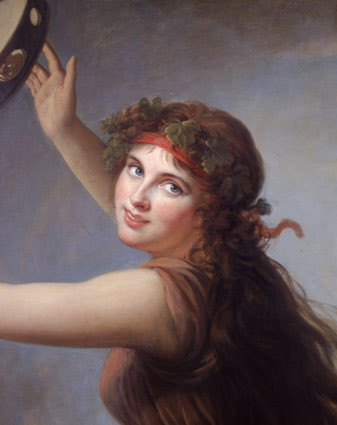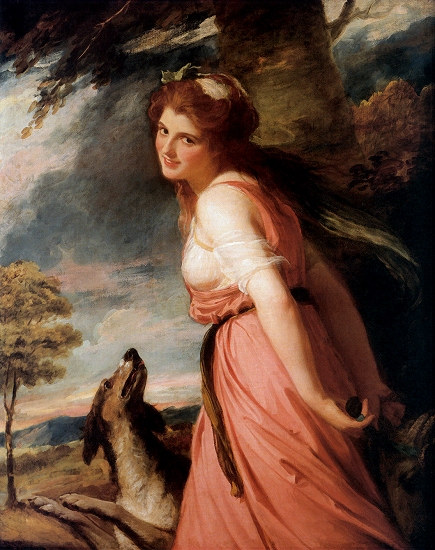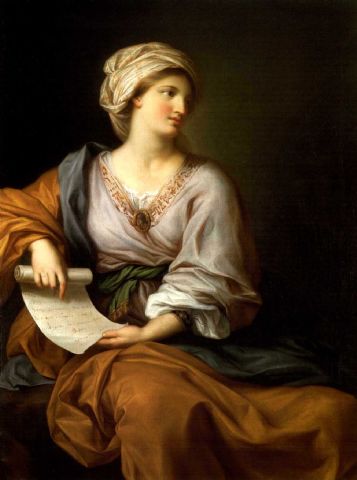When the ruins of Pompeii came to light, they caused a revolution in taste- stripping away rococo gilt, reshaping the female figure, and leaving a deposit of pseudo-Greek temples from Moscow to Mississippi; although what sometimes passed for “classical” would have bewildered the ancients…..
The unearthing of the ruins in Pompeii beginning in 1747 gave fresh vigor to the classical ideal. The discoveries brought to life the world of Greece and Rome as of for the first time; obviously such experiences heightened the tourist’s desire to possess some relic of this world, which opened now as a whole museum of object awaiting them. The collectors and connoisseurs now bought with a renewed fervor, and they were willing to pay dearly. Soon, a stream of objects,- authentic, faked, and indifferent – was soon flowing across the Continent to fill their studies and decorate the garden of the wealthy in England. The world of fashion had gone Pompeii mad.

---Emma's allure was so extraordinary that the noted portraitist George Romney was commissioned to capture her beauty on canvas. The moment that he laid eyes on her, Romney was spellbound--so much so, that he spent the rest of his career immortalizing her beauty in one painting after another. The artist "was patently in love with his model," Romney's biographer records, but "it was a worshipful obsession on Romney's part, with Emma, like Dante's Beatrice, as the focus of his inspiration" (Cross 121). Romney never freed himself of Emma's spell: For many years, Romney continued to work on pictures of Emma even after she had left England. In all she sat for him almost 300 times and he made over 50 pictures of her. It was Romney's paintings of her which preserved her image and helped establish her enduring fame. Emma was Romney's muse, stirring him to greater art.---
The English visitors were extremely fortunate in their host, for Sir William Hamilton, Plenipotentiary at naples for thirty-six years ( 1764-1800) , was both warmly hospitable and immersed in the new discoveries. He might occasionally tire of the hordes of tourists, but he never failed to entertain his visitors, or to instruct them in the finer points of excavations. As enthusiastic as he was knowledgeable , he never tired of showing his visitors over Vesuvius and the new finds, on both of which he was a considerable expert.

Judgement of Paris.com:Emma first attracted notice through a dalliance with an English nobleman, and even as an early age, it was apparent to everyone who saw her that she had been blessed with the "beauty that nature bestows but once or twice in a century" (Barrington 31). "Emma was luscious," history tells us, "with a lovely girlish face on a full woman's body barely concealed by the thin muslin dresses she wore" (Russell 31). And it was the juxtaposition of those soft facial features with a decadently opulent figure--a voluptuous goddess with the face of an angel--that made Lady Hamilton the definitive contemporary incarnation of timeless beauty: Nothing could be more beautiful than her countenance or more commanding than her figure at this time; the first had an unusual mixture of angelic softness . . . the other . . . would equally have served for the splendour of an Imperial throne, or the couch of voluptuous sensuality. (Sherrard 232)---
As a close friend of Queen maria Carolina of Naples, he had easy access to the excavations, and his guests were rarely disappointed , for it had become the custom at Herculaneum to “lay on” finds for distinguished visitors. Fine bronzes and particularly impressive statues were carefully reburied and brought to light with excited cries of surprise and congratulation just as the visitors arrived or immediately after they moved their first spadeful of earth. The most spectacular finds were kept, if possible, for Queen Maria Carolina herself. Her delighted enthusiasm- and her splendid tips- more than repaid the thoughtful timing of such discoveries. For even the most unimportant visitor , the diggers could usually manage a coin or a marble fragment, if he was accompanied by Sir William.
However, Sir William had more to offer than hospitality, expertise, and an entree to the digs. He had also a “living antique” , his lovely young mistress, Emma, who later became his wife, and later, the mistress of Lord Nelson. Sir William had acquired her from his nephew, Charles Greville, who in the course of a correspondence, which startles by its cold blooded common sense and unhinged frankness, assured him, “You will have comfort with the prettiest woman confessedly in London”. The poets and painters would say more…A Modern, who will not render your criticisms of the Antique less pure.” As Goethe wrote, “In her he finds the charm of all antiques, the fair profiles onSicilian coins, the Apollo Belvedere himself.”

Judgement of paris.com:No one revered her Classical qualities more than did her besotted husband, Sir William Hamilton. A collector of Greek antiquities, and a scholar of some note, Hamilton conceived of Emma as Helen of Troy for the 1790s. "She was Hamilton's living embodiment of ideal Greek beauty," history tells us, "the Galatea to his Pygmalion, whom he regarded with the eyes of a connoisseur and who became his own living work of art" (Jenkins 84). In her letters, Emma remarks on the ardour of Sir William's courtship: You do not know how good Sr. Wm. is to me. he is doing every thing he can to make me happy. He has never dined out since I came here and indeed to speak the truth he is never out of my sight. He breakfasts, dines, sups, and is constantly by me, looking at my face. I can't stir a hand, a leg, or foot but he is marking it as graceful and fine. (Sherrard 85) Emma's increasingly curvaceous figure was particularly adored by Hamilton. As Emma notes in another letter: "He thinks I am grown much more handsome than I was, he does nothing all day but look at me and sigh" (Sherrard 86). True connoisseur of art that he was, Hamilton wanted the entire world to marvel at Emma's appearance. Emma records that "Sir Wm. is never so happy as when he is pointing out my beauties to...
Apart from her beauty, she possessed a charm and gaiety of manner that captivated her most hostile critics and an acting skill that she employed in her “Grecian attitudes” . Draped in a few yards of gauze, and standing in a black-lined box framed in gold, Emma entranced European society by portraying the various attitudes of the figures found at Herculaneum and thus one for them new fame all over the Continent. The cynics may say that she was merely adapting the skills she had learned while posing in indecent “tableaux vivants” in the stews of London, and they may well be right, but it did not affect her popularity in the least. Her Grecian eurythmics, as they came to be called, were copied by hordes of aspiring hostesses in every European capital.

---regencylady.webs.com:When Nelson was recalled back to England, the three meandered back to Brittian via Central Europe and eventually arrived later in 1800 to a hero's welcome. The three then openly lived together, making the affair public knowledge and Nelson was eventually sent back to sea to remove him from Emma. Emma gave birth to Nelson's daughter, Horatia on January 31, 1801 and Sir William rented a home on Clarges Street in London. That same autumn Nelson bought Merton Place, a small house on the outskirts of modern day Wimbledon where he lived openly with Emma. Emma's popularity soared, and the newspapers reported on her every move, looking to her to set trends in everything from fashion to dinner menus. Sir William died in 1803 and Nelson returned to sea soon after, leaving Emma pregnant with their second child. The child died shortly after her birth and Emma, lonely and depressed turned gambling to distract herself. Nelson died at sea in 1805 by which time Emma had exhausted the small pension Sir William had left her and fell deeply into dept. Despite being a hero, Nelson's request for Emma and Horatia to be looked after were ignored and all of Nelson's estate and honours were given to his brother. Emma and Horatia spent a year in debters prison before moving to France to escape their creditors. Emma turned to drinking and died of amoebic dysentery, an illness she probably picked up in Naples (Sir William Also suffered from this), in Calais in January 1815. Horatia married Rev. Phillip Ward and lived until 188, she had 10 children....
ADDENDUM:
…At this time The Royal Academy was having great difficulty finding models for their artists because the work was considered ‘unbecoming’, Emma however became a favorite model of Sir Joshua Reynolds and George Romney. Many Hundreds of paintings were painted of Emma, especially by Romney who became obsessed with her. Emma took on pseudonyms such as ‘Emma Potts,’ ‘Emily Potts,’ ‘Miss Emily,’ ‘Warren,’ ‘Beartie,’ and ‘Coventry’. Emma then worked as a model and dancer at the “Goddess of Health” for James Graham a Scottish “quack” doctor. The establishment’s greatest attraction being a bed with which electricity was passed giving patrons mild shocks. This supposidly aided conception and many infertile couples paid high prices to try it. One patron who paid for pleasure not conception was 18 year old George IV who sampled the bed with his Mistress Mary Robinson who had been one of the actress
hat Emma had been a maid for.
At the age of 15 Emma took on work at ‘Madame Kelly’s’ an exclusive brothel next to the Ritz Hotel. It had been reported in Town and Country Magazine that a woman looking very much like Emma had set up there. The magazine coyly refered to the establishment as “Santa Carolotta’s Nunnery”. It was there that Emma begain to refine her lewid postures for her more refined clients. One of Emma’s clients was Sir Harry Featherstonehaugh. She was hired by Sir Harry for several monthes from the brothel as the host and entertainer at a lengthy stag party at his country estate in South Downs. Sir Harry took Emma as his mistress but often neglected her for drinking and hunting. In late June early July of 1781 Emma conceived a child by Sir Harry. Sir Harry was furious by the unwanted pregnancy and placed Emma at one of his London houses. Sir Harry ignored Emma’s advances after this point and she then turned her attentions to his friend, Charles Frances Greville. Her daugher, Emma Carew was removed to be raised by a Mr. and Mrs. Blackbburn after she was born. Carew saw her mother frequently while growing up but when Emma went to debters prison Carew was forced to leave the country to work abroad as a companion or governess….








 COMMENTS
COMMENTS



